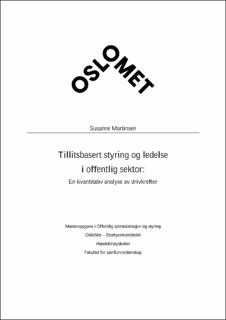| dc.description.abstract | Norway is looking to new forms of governance after much criticism directed at governance and management in the public sector. In this connection, a trust reform is widely discussed within public administration policy, as an attempt to solve the complex challenges associated with governance and management in the public sector in Norway. The existing form of governance must therefore move towards a "trust-based governance and management". Trust-based governance and management can be described as governance, culture and working methods where the ambition is to create better conditions for self-governance and self-management. Trust-based governance and management wants increased autonomy for managers and employees with an emphasis on the relationship between control and trust with the right balance. This must be based on mutual trust between the parties in the workplace. The fundamental changes from the existing form of governance are primarily about how people and institutions interact with each other.
Using a quantitative method, the thesis investigates if the degree of publicness, organizational size and general trust, effects the change in perceived trust-based governance and management by managers or employees at four experience-based master's programs in public governance and management. The analysis has been carried out using multiple regression analysis to provide an answer to how much each of the independent variables affects the variation in changed trust-based governance and management. The data I use is based on a pilot survey obtained in connection with the trust project - "Improving trust-based management in Nordic urban governance and management education".
The result shows that the independent variables; degree of publicness, organizational size and general trust explains little of the variation in the change in trust-based governance and management. Organizational size is the only variable in the analysis that has a significant relationship with trust-based governance and management. This relationship had a negative direction. Which means that employees in large organizations will experience less change in trust-based governance and management from 2017 to 2019 than employees in small organizations. A sector that is more public, or employee with higher general trust will not necessarily experience change in trust-based governance and management based on the results in this analysis. | en_US |
